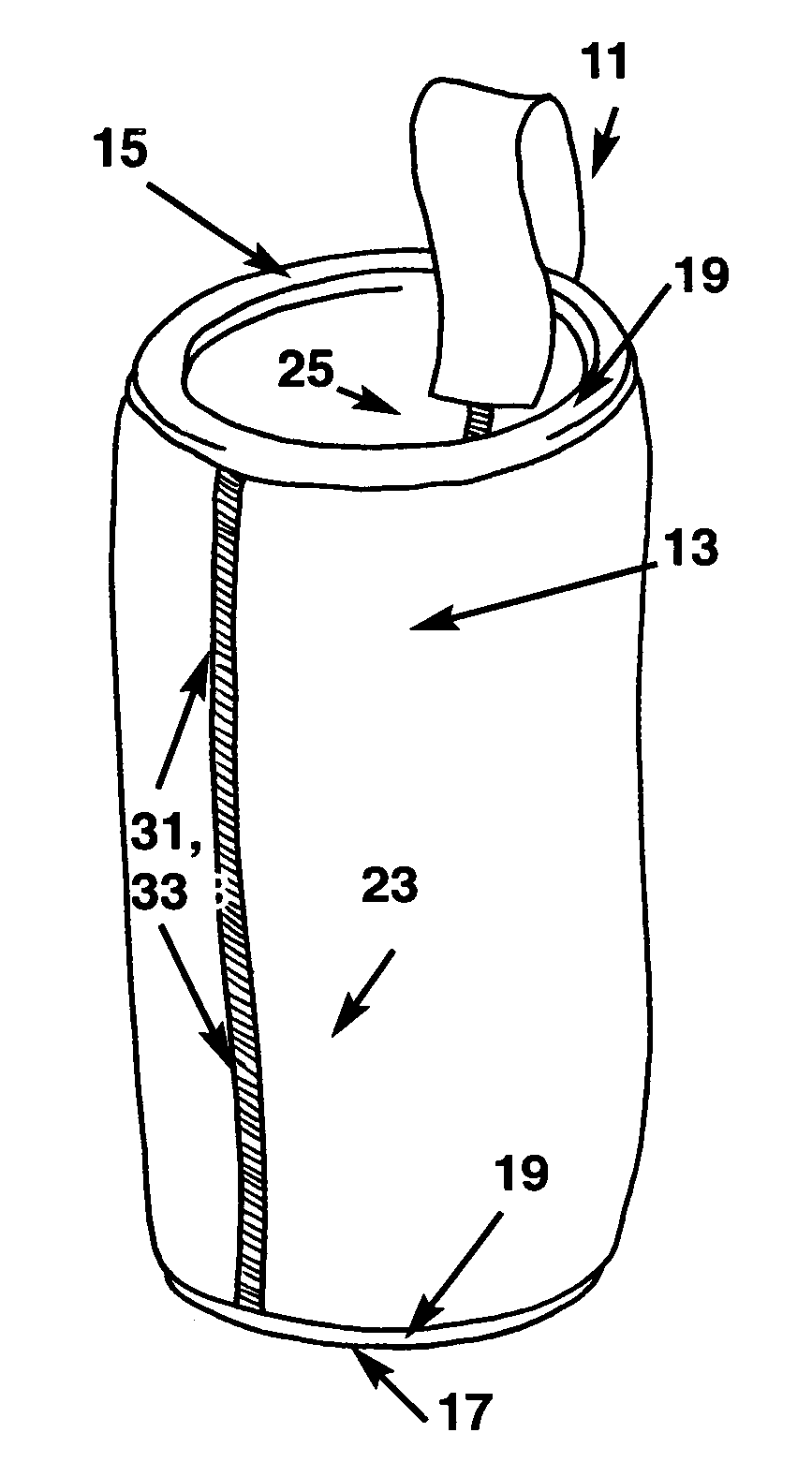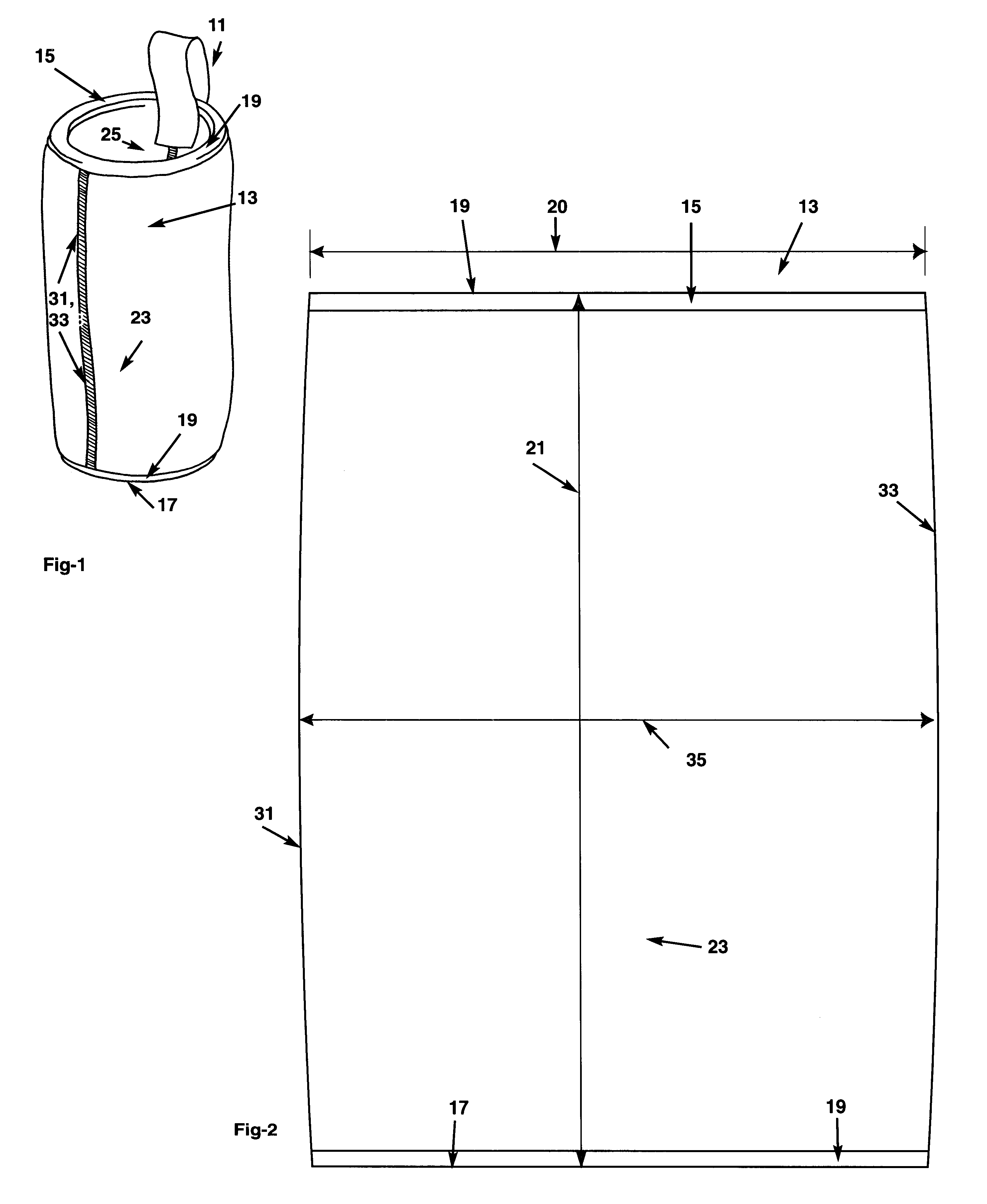Highly adaptable thermal insulator for adapting to an unprecedented range of sizes and shapes of beverage containers
a beverage container and thermal insulation technology, applied in the field of beverage container insulation, can solve the problems of not being able to adapt to different sized containers, french design probably has a very limited range of adaptability, and not being able to adapt to the shapes and sizes of a wide range of containers
- Summary
- Abstract
- Description
- Claims
- Application Information
AI Technical Summary
Problems solved by technology
Method used
Image
Examples
first embodiment
In the present invention, each panel 13 has substantially straight, horizontal top and bottom edges 15, 17, respectively. Each edge 15, 17 measures approximately 12.75 cm in width 20 between their respective ends. During use of insulator 11, panels 13 will have an upright or "vertical orientation," wherein top and bottom edges 15, 17 are oriented "horizontally" at the top and bottom, respectively, of insulator 11. In this disclosure, the term "horizontal" refers to a direction that is substantially perpendicular to "vertical." Top and bottom edges 15, 17 are parallel and define a substantially consistent, overall vertical dimension or height 21 therebetween for panel 13 of approximately 16.75 cm.
Each edge 15, 17 is provided with a horizontal, circumscribing, elastic band or hem 19 that has a vertical dimension of approximately 9 mm. In the version shown, hems 19 are formed from an elastic material, but are preferably black in color regardless of the color or illustration emblazoned ...
second embodiment
Referring now to FIG. 3, the present invention is shown as beverage container insulator 41. Insulator 41 is virtually identical to insulator 11 in form and function, except that insulator 41 is slightly smaller in size and specifically designed for use with beverage containers having a fluid capacity of approximately 500 to 750 ml. For example, comparing FIGS. 15 and 16, the same insulator 41 may be used interchangeably on bottle shapes such as odd shape bottles, tall round bottles with full, medium, or narrow necks, short round bottles, and tall narrow bottles. Thus, insulator 41 readily fits and contours to each of these beverage containers.
Insulator 41 is also ideally formed from two (or more) of the panels 43 (FIG. 4) of neoprene, each having two reversible surfaces 53, 55. Each panel 43 also has horizontal top and bottom edges 45, 47, respectively, measuring approximately 10 cm in width 50. Top and bottom edges 45, 47 have a vertical dimension 51 of approximately 15 cm. Each ed...
third embodiment
Referring now to FIG. 5, the present invention is shown as beverage container insulator 71. Insulator 71 is the smallest embodiment and designed for use with a variety of smaller beverage containers having a fluid capacity of approximately 10 to 12 oz. For example, by comparing FIGS. 17 and 18, it is readily apparent that the same insulator 71 may be used interchangeably on bottle shapes such as such as common juice bottles, common carbonated beverage cans, and very round juice bottles. Thus, insulator 71 readily fits and conforms to each of these beverage containers.
Insulator 71 comprises two panels 73 (FIG. 6), each having two reversible surfaces 83, 85, and horizontal top and bottom edges 75, 77, measuring approximately 10.0 cm in width 80. Likewise, top and bottom edges 75, 77 have a vertical dimension 81 of approximately 10.0 cm. Each edge 15, 17 is provided with an elastic hem 79 having a vertical dimension of approximately 9 mm.
The curved side edges 91, 93 of panel 73 define ...
PUM
 Login to View More
Login to View More Abstract
Description
Claims
Application Information
 Login to View More
Login to View More - R&D
- Intellectual Property
- Life Sciences
- Materials
- Tech Scout
- Unparalleled Data Quality
- Higher Quality Content
- 60% Fewer Hallucinations
Browse by: Latest US Patents, China's latest patents, Technical Efficacy Thesaurus, Application Domain, Technology Topic, Popular Technical Reports.
© 2025 PatSnap. All rights reserved.Legal|Privacy policy|Modern Slavery Act Transparency Statement|Sitemap|About US| Contact US: help@patsnap.com



